Ethical Clothing: Addressing Challenges for a Just Society (UNCC300)
VerifiedAdded on 2022/11/19
|6
|1575
|120
Essay
AI Summary
This essay delves into the critical issues surrounding ethical clothing, examining its impact on the common good both locally and globally. It critiques how the current practices of the fashion industry challenge the principles of the common good, particularly in relation to human dignity. The essay highlights the lack of consumer awareness and the complexities of ethical consumption, emphasizing the need for a shift towards sustainable fashion. It proposes various solutions to address these challenges, including raising consumer awareness, mainstreaming ethical clothing through advocacy and community engagement, and encouraging responsible practices among producers and sellers. The essay emphasizes the importance of transparency, investment in sustainable clothes, and a collective effort to promote a more just and ethical fashion industry, advocating for a mindset change among consumers and highlighting the role of community involvement in fostering sustainable practices and resource management. The essay uses multiple sources to support the arguments and also refers to the assignment brief which requires the student to discuss ethical clothing, critique how the common good is challenged by this issue locally and globally, and propose ways to address the challenge for a more just society.
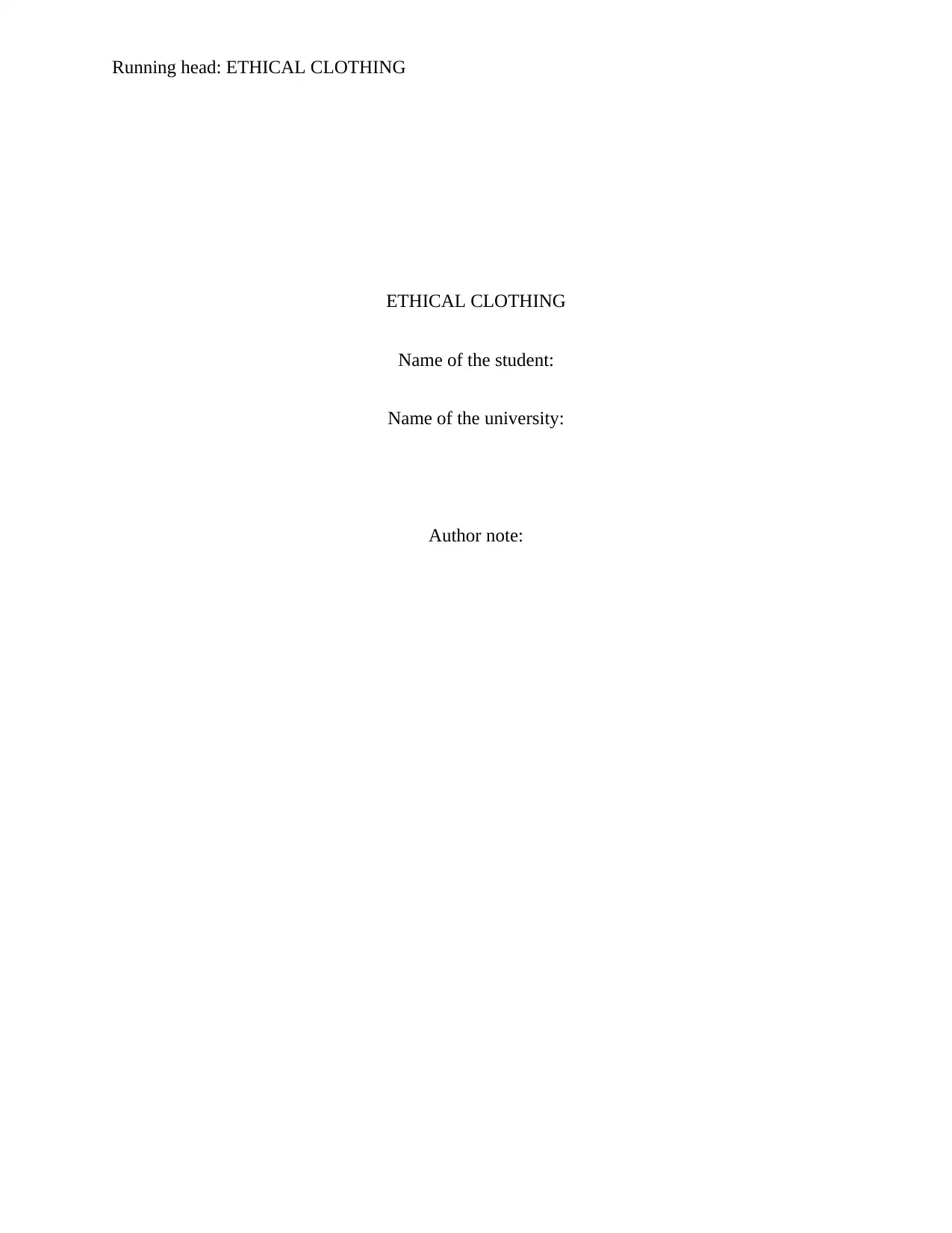
Running head: ETHICAL CLOTHING
ETHICAL CLOTHING
Name of the student:
Name of the university:
Author note:
ETHICAL CLOTHING
Name of the student:
Name of the university:
Author note:
Paraphrase This Document
Need a fresh take? Get an instant paraphrase of this document with our AI Paraphraser
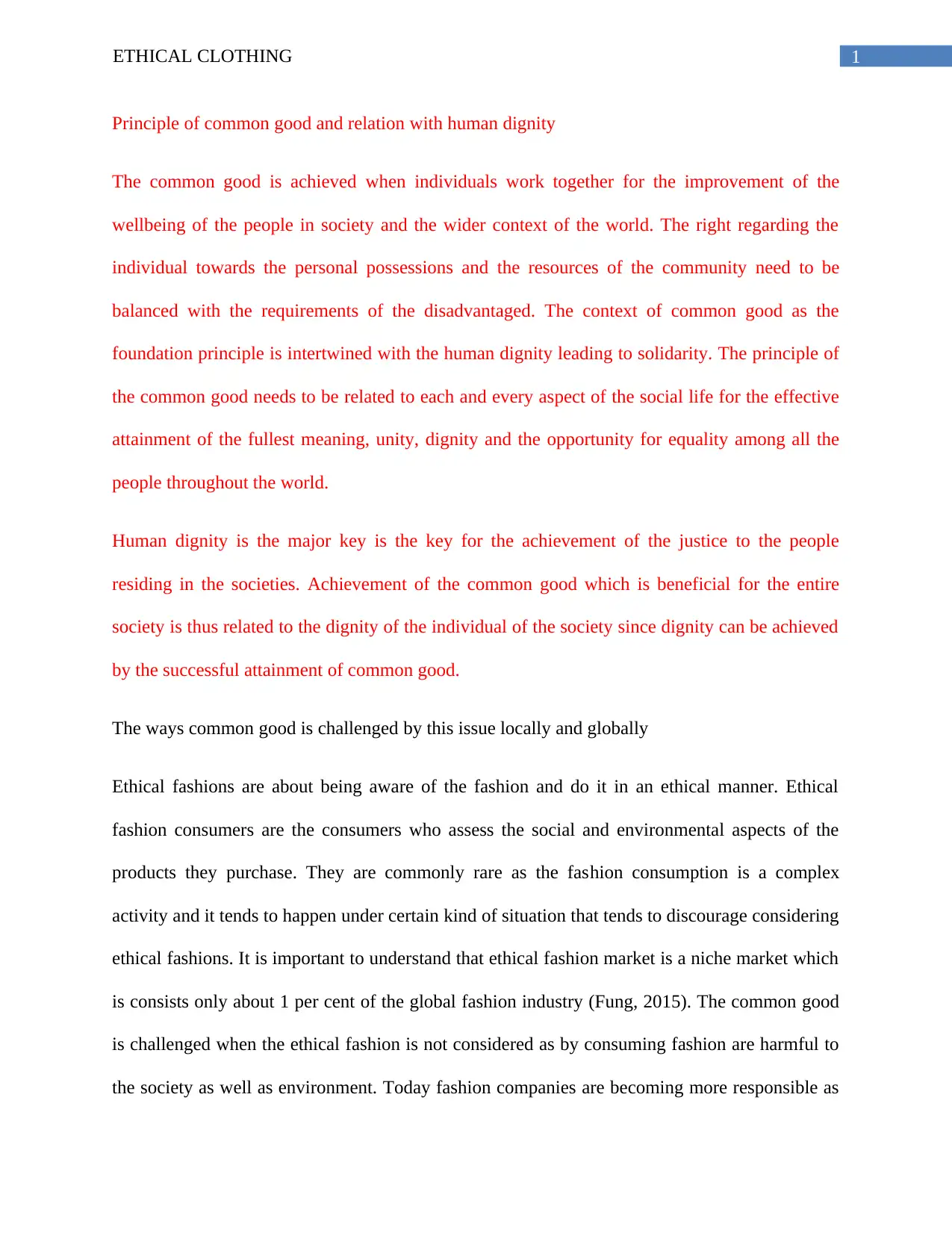
1ETHICAL CLOTHING
Principle of common good and relation with human dignity
The common good is achieved when individuals work together for the improvement of the
wellbeing of the people in society and the wider context of the world. The right regarding the
individual towards the personal possessions and the resources of the community need to be
balanced with the requirements of the disadvantaged. The context of common good as the
foundation principle is intertwined with the human dignity leading to solidarity. The principle of
the common good needs to be related to each and every aspect of the social life for the effective
attainment of the fullest meaning, unity, dignity and the opportunity for equality among all the
people throughout the world.
Human dignity is the major key is the key for the achievement of the justice to the people
residing in the societies. Achievement of the common good which is beneficial for the entire
society is thus related to the dignity of the individual of the society since dignity can be achieved
by the successful attainment of common good.
The ways common good is challenged by this issue locally and globally
Ethical fashions are about being aware of the fashion and do it in an ethical manner. Ethical
fashion consumers are the consumers who assess the social and environmental aspects of the
products they purchase. They are commonly rare as the fashion consumption is a complex
activity and it tends to happen under certain kind of situation that tends to discourage considering
ethical fashions. It is important to understand that ethical fashion market is a niche market which
is consists only about 1 per cent of the global fashion industry (Fung, 2015). The common good
is challenged when the ethical fashion is not considered as by consuming fashion are harmful to
the society as well as environment. Today fashion companies are becoming more responsible as
Principle of common good and relation with human dignity
The common good is achieved when individuals work together for the improvement of the
wellbeing of the people in society and the wider context of the world. The right regarding the
individual towards the personal possessions and the resources of the community need to be
balanced with the requirements of the disadvantaged. The context of common good as the
foundation principle is intertwined with the human dignity leading to solidarity. The principle of
the common good needs to be related to each and every aspect of the social life for the effective
attainment of the fullest meaning, unity, dignity and the opportunity for equality among all the
people throughout the world.
Human dignity is the major key is the key for the achievement of the justice to the people
residing in the societies. Achievement of the common good which is beneficial for the entire
society is thus related to the dignity of the individual of the society since dignity can be achieved
by the successful attainment of common good.
The ways common good is challenged by this issue locally and globally
Ethical fashions are about being aware of the fashion and do it in an ethical manner. Ethical
fashion consumers are the consumers who assess the social and environmental aspects of the
products they purchase. They are commonly rare as the fashion consumption is a complex
activity and it tends to happen under certain kind of situation that tends to discourage considering
ethical fashions. It is important to understand that ethical fashion market is a niche market which
is consists only about 1 per cent of the global fashion industry (Fung, 2015). The common good
is challenged when the ethical fashion is not considered as by consuming fashion are harmful to
the society as well as environment. Today fashion companies are becoming more responsible as
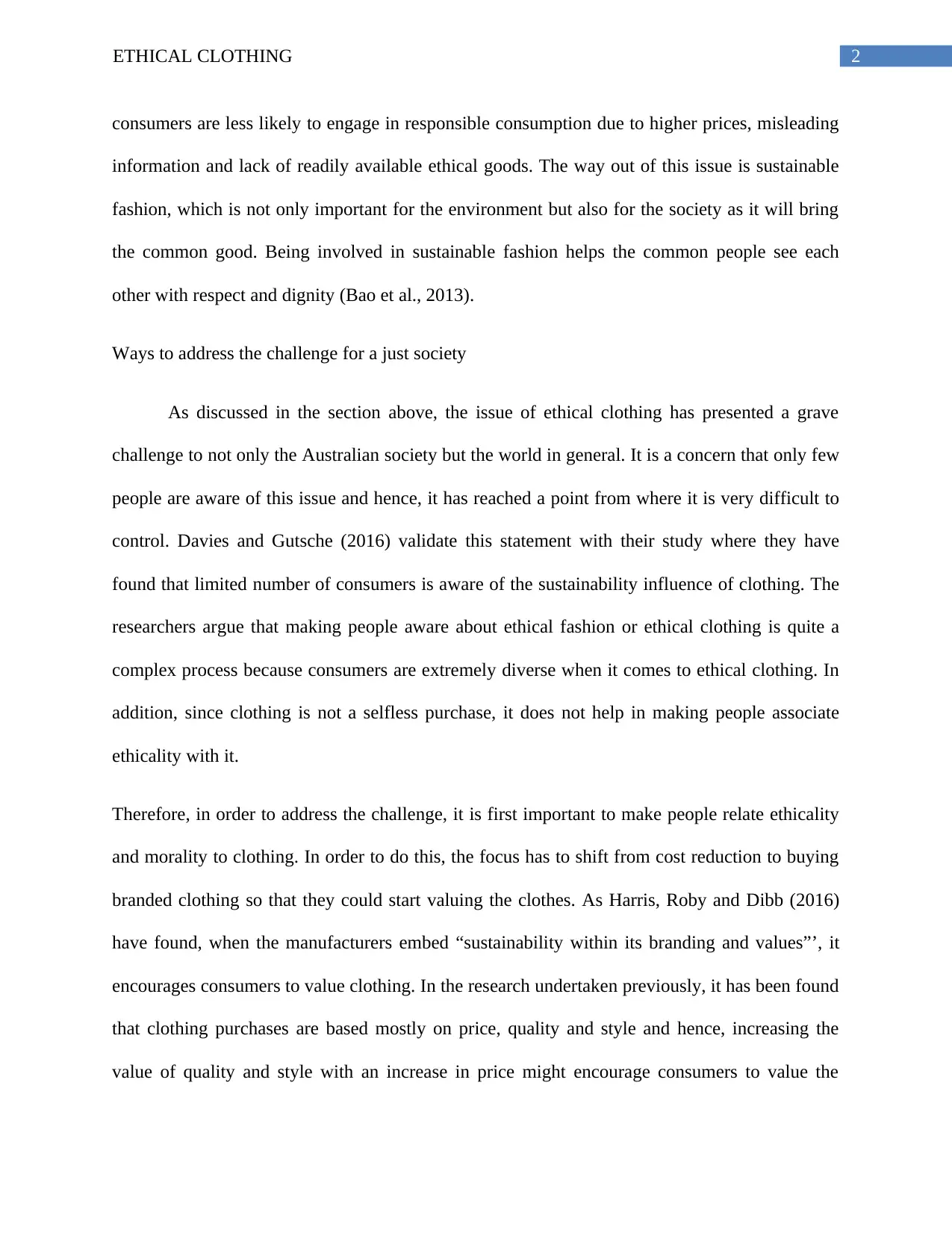
2ETHICAL CLOTHING
consumers are less likely to engage in responsible consumption due to higher prices, misleading
information and lack of readily available ethical goods. The way out of this issue is sustainable
fashion, which is not only important for the environment but also for the society as it will bring
the common good. Being involved in sustainable fashion helps the common people see each
other with respect and dignity (Bao et al., 2013).
Ways to address the challenge for a just society
As discussed in the section above, the issue of ethical clothing has presented a grave
challenge to not only the Australian society but the world in general. It is a concern that only few
people are aware of this issue and hence, it has reached a point from where it is very difficult to
control. Davies and Gutsche (2016) validate this statement with their study where they have
found that limited number of consumers is aware of the sustainability influence of clothing. The
researchers argue that making people aware about ethical fashion or ethical clothing is quite a
complex process because consumers are extremely diverse when it comes to ethical clothing. In
addition, since clothing is not a selfless purchase, it does not help in making people associate
ethicality with it.
Therefore, in order to address the challenge, it is first important to make people relate ethicality
and morality to clothing. In order to do this, the focus has to shift from cost reduction to buying
branded clothing so that they could start valuing the clothes. As Harris, Roby and Dibb (2016)
have found, when the manufacturers embed “sustainability within its branding and values”’, it
encourages consumers to value clothing. In the research undertaken previously, it has been found
that clothing purchases are based mostly on price, quality and style and hence, increasing the
value of quality and style with an increase in price might encourage consumers to value the
consumers are less likely to engage in responsible consumption due to higher prices, misleading
information and lack of readily available ethical goods. The way out of this issue is sustainable
fashion, which is not only important for the environment but also for the society as it will bring
the common good. Being involved in sustainable fashion helps the common people see each
other with respect and dignity (Bao et al., 2013).
Ways to address the challenge for a just society
As discussed in the section above, the issue of ethical clothing has presented a grave
challenge to not only the Australian society but the world in general. It is a concern that only few
people are aware of this issue and hence, it has reached a point from where it is very difficult to
control. Davies and Gutsche (2016) validate this statement with their study where they have
found that limited number of consumers is aware of the sustainability influence of clothing. The
researchers argue that making people aware about ethical fashion or ethical clothing is quite a
complex process because consumers are extremely diverse when it comes to ethical clothing. In
addition, since clothing is not a selfless purchase, it does not help in making people associate
ethicality with it.
Therefore, in order to address the challenge, it is first important to make people relate ethicality
and morality to clothing. In order to do this, the focus has to shift from cost reduction to buying
branded clothing so that they could start valuing the clothes. As Harris, Roby and Dibb (2016)
have found, when the manufacturers embed “sustainability within its branding and values”’, it
encourages consumers to value clothing. In the research undertaken previously, it has been found
that clothing purchases are based mostly on price, quality and style and hence, increasing the
value of quality and style with an increase in price might encourage consumers to value the
⊘ This is a preview!⊘
Do you want full access?
Subscribe today to unlock all pages.

Trusted by 1+ million students worldwide
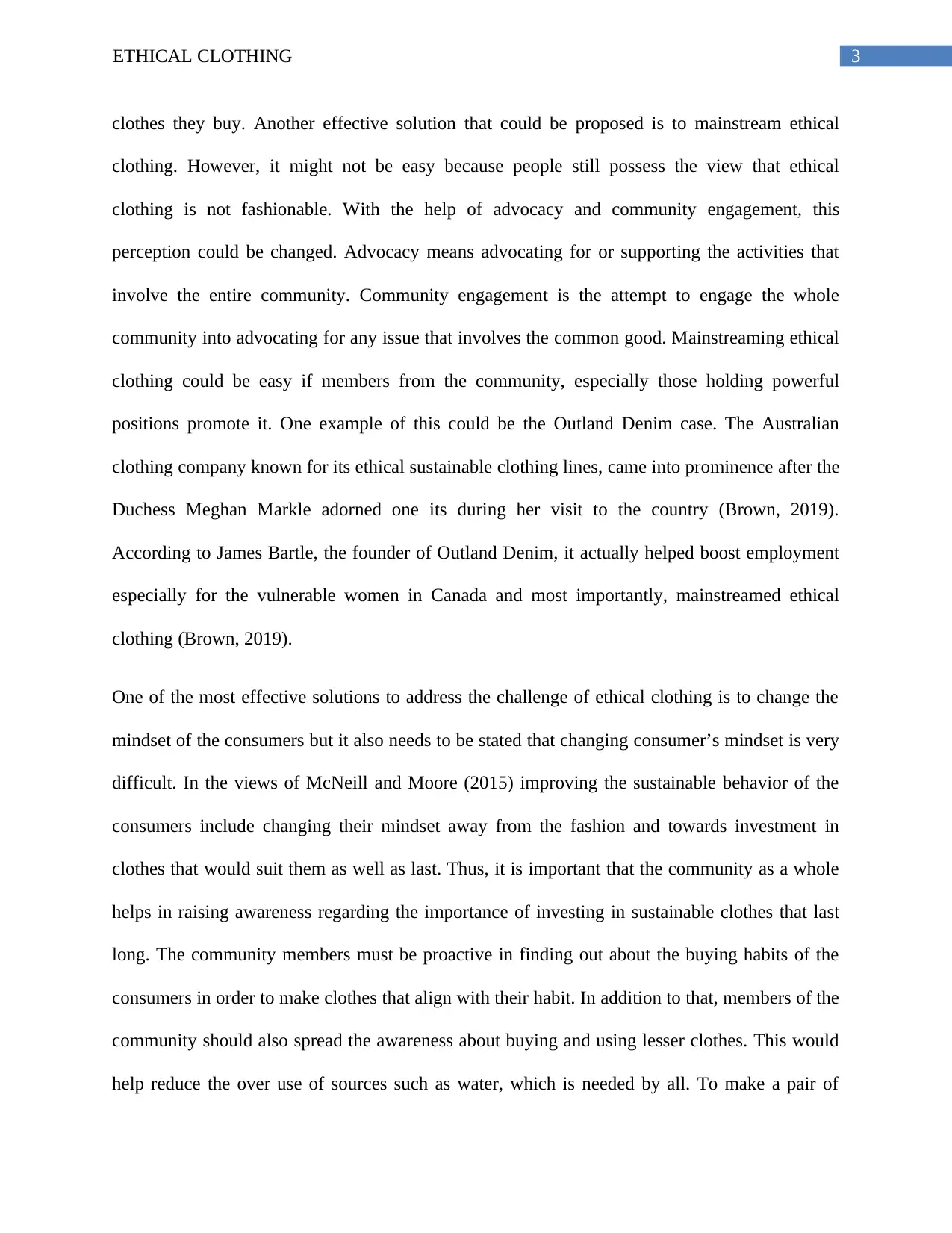
3ETHICAL CLOTHING
clothes they buy. Another effective solution that could be proposed is to mainstream ethical
clothing. However, it might not be easy because people still possess the view that ethical
clothing is not fashionable. With the help of advocacy and community engagement, this
perception could be changed. Advocacy means advocating for or supporting the activities that
involve the entire community. Community engagement is the attempt to engage the whole
community into advocating for any issue that involves the common good. Mainstreaming ethical
clothing could be easy if members from the community, especially those holding powerful
positions promote it. One example of this could be the Outland Denim case. The Australian
clothing company known for its ethical sustainable clothing lines, came into prominence after the
Duchess Meghan Markle adorned one its during her visit to the country (Brown, 2019).
According to James Bartle, the founder of Outland Denim, it actually helped boost employment
especially for the vulnerable women in Canada and most importantly, mainstreamed ethical
clothing (Brown, 2019).
One of the most effective solutions to address the challenge of ethical clothing is to change the
mindset of the consumers but it also needs to be stated that changing consumer’s mindset is very
difficult. In the views of McNeill and Moore (2015) improving the sustainable behavior of the
consumers include changing their mindset away from the fashion and towards investment in
clothes that would suit them as well as last. Thus, it is important that the community as a whole
helps in raising awareness regarding the importance of investing in sustainable clothes that last
long. The community members must be proactive in finding out about the buying habits of the
consumers in order to make clothes that align with their habit. In addition to that, members of the
community should also spread the awareness about buying and using lesser clothes. This would
help reduce the over use of sources such as water, which is needed by all. To make a pair of
clothes they buy. Another effective solution that could be proposed is to mainstream ethical
clothing. However, it might not be easy because people still possess the view that ethical
clothing is not fashionable. With the help of advocacy and community engagement, this
perception could be changed. Advocacy means advocating for or supporting the activities that
involve the entire community. Community engagement is the attempt to engage the whole
community into advocating for any issue that involves the common good. Mainstreaming ethical
clothing could be easy if members from the community, especially those holding powerful
positions promote it. One example of this could be the Outland Denim case. The Australian
clothing company known for its ethical sustainable clothing lines, came into prominence after the
Duchess Meghan Markle adorned one its during her visit to the country (Brown, 2019).
According to James Bartle, the founder of Outland Denim, it actually helped boost employment
especially for the vulnerable women in Canada and most importantly, mainstreamed ethical
clothing (Brown, 2019).
One of the most effective solutions to address the challenge of ethical clothing is to change the
mindset of the consumers but it also needs to be stated that changing consumer’s mindset is very
difficult. In the views of McNeill and Moore (2015) improving the sustainable behavior of the
consumers include changing their mindset away from the fashion and towards investment in
clothes that would suit them as well as last. Thus, it is important that the community as a whole
helps in raising awareness regarding the importance of investing in sustainable clothes that last
long. The community members must be proactive in finding out about the buying habits of the
consumers in order to make clothes that align with their habit. In addition to that, members of the
community should also spread the awareness about buying and using lesser clothes. This would
help reduce the over use of sources such as water, which is needed by all. To make a pair of
Paraphrase This Document
Need a fresh take? Get an instant paraphrase of this document with our AI Paraphraser
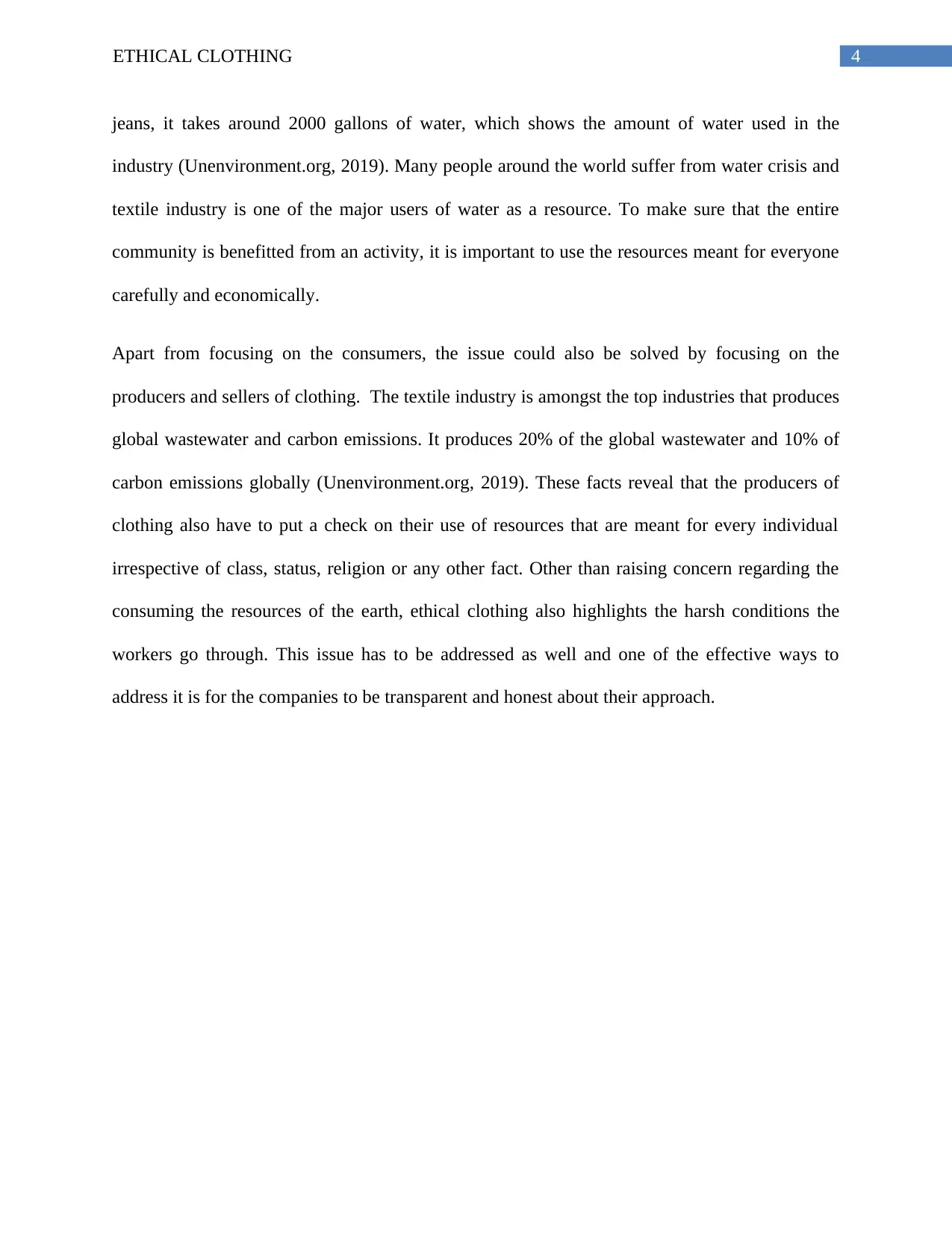
4ETHICAL CLOTHING
jeans, it takes around 2000 gallons of water, which shows the amount of water used in the
industry (Unenvironment.org, 2019). Many people around the world suffer from water crisis and
textile industry is one of the major users of water as a resource. To make sure that the entire
community is benefitted from an activity, it is important to use the resources meant for everyone
carefully and economically.
Apart from focusing on the consumers, the issue could also be solved by focusing on the
producers and sellers of clothing. The textile industry is amongst the top industries that produces
global wastewater and carbon emissions. It produces 20% of the global wastewater and 10% of
carbon emissions globally (Unenvironment.org, 2019). These facts reveal that the producers of
clothing also have to put a check on their use of resources that are meant for every individual
irrespective of class, status, religion or any other fact. Other than raising concern regarding the
consuming the resources of the earth, ethical clothing also highlights the harsh conditions the
workers go through. This issue has to be addressed as well and one of the effective ways to
address it is for the companies to be transparent and honest about their approach.
jeans, it takes around 2000 gallons of water, which shows the amount of water used in the
industry (Unenvironment.org, 2019). Many people around the world suffer from water crisis and
textile industry is one of the major users of water as a resource. To make sure that the entire
community is benefitted from an activity, it is important to use the resources meant for everyone
carefully and economically.
Apart from focusing on the consumers, the issue could also be solved by focusing on the
producers and sellers of clothing. The textile industry is amongst the top industries that produces
global wastewater and carbon emissions. It produces 20% of the global wastewater and 10% of
carbon emissions globally (Unenvironment.org, 2019). These facts reveal that the producers of
clothing also have to put a check on their use of resources that are meant for every individual
irrespective of class, status, religion or any other fact. Other than raising concern regarding the
consuming the resources of the earth, ethical clothing also highlights the harsh conditions the
workers go through. This issue has to be addressed as well and one of the effective ways to
address it is for the companies to be transparent and honest about their approach.
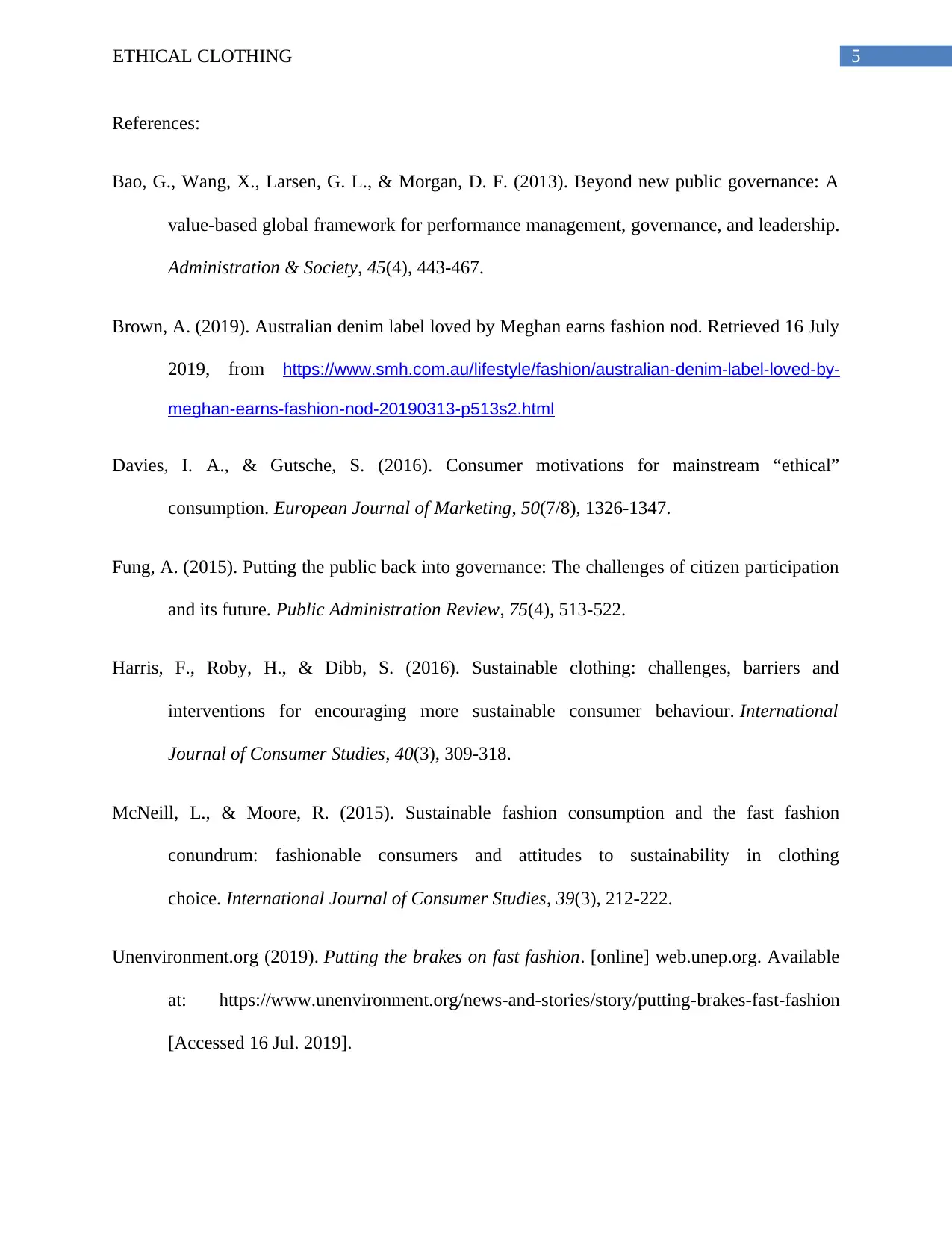
5ETHICAL CLOTHING
References:
Bao, G., Wang, X., Larsen, G. L., & Morgan, D. F. (2013). Beyond new public governance: A
value-based global framework for performance management, governance, and leadership.
Administration & Society, 45(4), 443-467.
Brown, A. (2019). Australian denim label loved by Meghan earns fashion nod. Retrieved 16 July
2019, from https://www.smh.com.au/lifestyle/fashion/australian-denim-label-loved-by-
meghan-earns-fashion-nod-20190313-p513s2.html
Davies, I. A., & Gutsche, S. (2016). Consumer motivations for mainstream “ethical”
consumption. European Journal of Marketing, 50(7/8), 1326-1347.
Fung, A. (2015). Putting the public back into governance: The challenges of citizen participation
and its future. Public Administration Review, 75(4), 513-522.
Harris, F., Roby, H., & Dibb, S. (2016). Sustainable clothing: challenges, barriers and
interventions for encouraging more sustainable consumer behaviour. International
Journal of Consumer Studies, 40(3), 309-318.
McNeill, L., & Moore, R. (2015). Sustainable fashion consumption and the fast fashion
conundrum: fashionable consumers and attitudes to sustainability in clothing
choice. International Journal of Consumer Studies, 39(3), 212-222.
Unenvironment.org (2019). Putting the brakes on fast fashion. [online] web.unep.org. Available
at: https://www.unenvironment.org/news-and-stories/story/putting-brakes-fast-fashion
[Accessed 16 Jul. 2019].
References:
Bao, G., Wang, X., Larsen, G. L., & Morgan, D. F. (2013). Beyond new public governance: A
value-based global framework for performance management, governance, and leadership.
Administration & Society, 45(4), 443-467.
Brown, A. (2019). Australian denim label loved by Meghan earns fashion nod. Retrieved 16 July
2019, from https://www.smh.com.au/lifestyle/fashion/australian-denim-label-loved-by-
meghan-earns-fashion-nod-20190313-p513s2.html
Davies, I. A., & Gutsche, S. (2016). Consumer motivations for mainstream “ethical”
consumption. European Journal of Marketing, 50(7/8), 1326-1347.
Fung, A. (2015). Putting the public back into governance: The challenges of citizen participation
and its future. Public Administration Review, 75(4), 513-522.
Harris, F., Roby, H., & Dibb, S. (2016). Sustainable clothing: challenges, barriers and
interventions for encouraging more sustainable consumer behaviour. International
Journal of Consumer Studies, 40(3), 309-318.
McNeill, L., & Moore, R. (2015). Sustainable fashion consumption and the fast fashion
conundrum: fashionable consumers and attitudes to sustainability in clothing
choice. International Journal of Consumer Studies, 39(3), 212-222.
Unenvironment.org (2019). Putting the brakes on fast fashion. [online] web.unep.org. Available
at: https://www.unenvironment.org/news-and-stories/story/putting-brakes-fast-fashion
[Accessed 16 Jul. 2019].
⊘ This is a preview!⊘
Do you want full access?
Subscribe today to unlock all pages.

Trusted by 1+ million students worldwide
1 out of 6
Related Documents
Your All-in-One AI-Powered Toolkit for Academic Success.
+13062052269
info@desklib.com
Available 24*7 on WhatsApp / Email
![[object Object]](/_next/static/media/star-bottom.7253800d.svg)
Unlock your academic potential
Copyright © 2020–2025 A2Z Services. All Rights Reserved. Developed and managed by ZUCOL.





